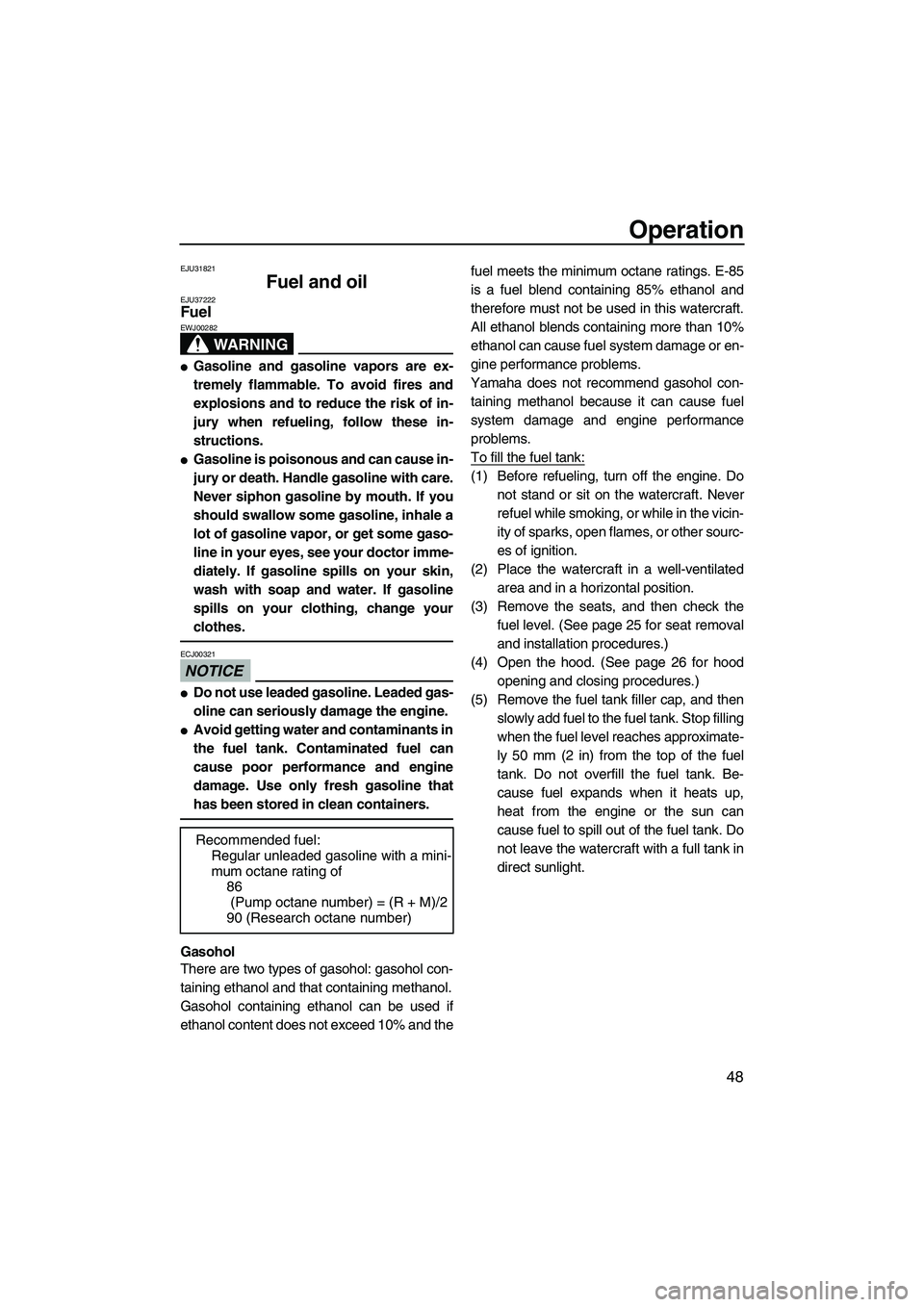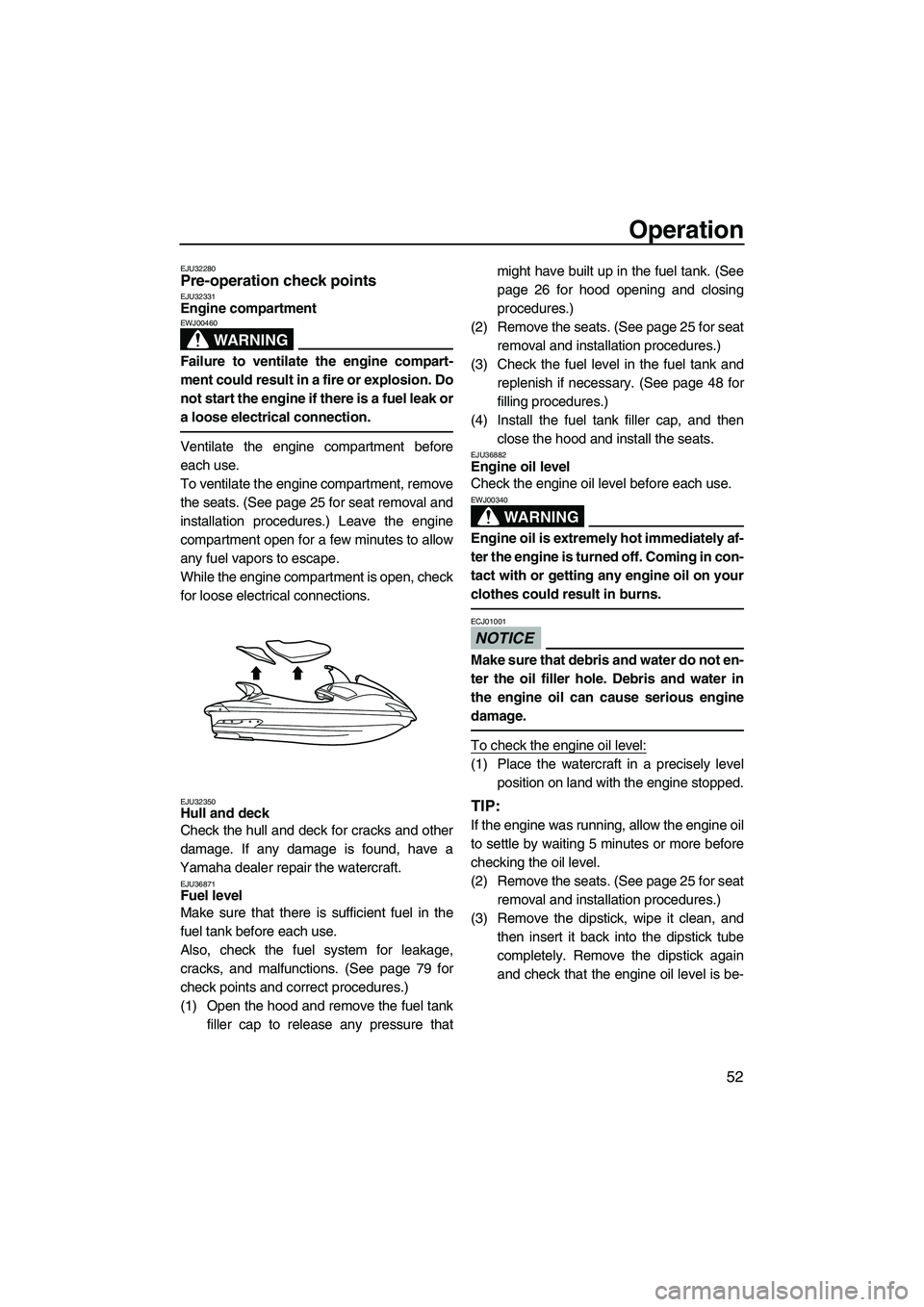Page 33 of 106

Features and functions
26
push the rear of the seat down to lock it in
place.
(2) Install the rear seat. Make sure that the
seats are securely installed before oper-
ating the watercraft.
EJU36682Hood
To open the hood, pull the visor up, and then
lift up the hood.To close the hood, push down on the center
of the hood until it latches securely. Make sure
that the hood is securely closed before oper-
ating the watercraft.
EJU36691Fuel tank filler cap
The fuel tank filler cap is located under the
hood.
To remove the fuel tank filler cap, open the
hood, and then turn the cap counterclockwise.
(See page 26 for hood opening and closing
procedures.)
To install the fuel tank filler cap, turn it clock-
wise until it stops. Make sure that the fuel tank
filler cap and the hood are securely closed be-
fore operating the watercraft.
EJU37121Remote control transmitter
The Yamaha Security System and low-RPM
mode settings are selected using the remote
control transmitter. (See “Yamaha Security1Visor
1
1Fuel tank filler cap
1
UF2H70E0.book Page 26 Thursday, January 15, 2009 10:49 AM
Page 53 of 106
Features and functions
46
To open the front storage compartment, pull
the visor up, and then lift up the hood.To close the front storage compartment, push
down on the center of the hood until it latches
securely.
EJU35161Glove compartment
The glove compartment is located in front of
the seat.
To open the glove compartment, turn the
glove compartment knob, and then lift up the
lid.
1Visor
1Front storage compartment
Front storage compartment:
Capacity:
66.0 L (17.4 US gal, 14.5 Imp.gal)
Load limit:
5.0 kg (11 lb)
1
1
1Glove compartment knob
1Glove compartment
1
1
UF2H70E0.book Page 46 Thursday, January 15, 2009 10:49 AM
Page 55 of 106

Operation
48
EJU31821
Fuel and oil EJU37222Fuel
WARNING
EWJ00282
�Gasoline and gasoline vapors are ex-
tremely flammable. To avoid fires and
explosions and to reduce the risk of in-
jury when refueling, follow these in-
structions.
�Gasoline is poisonous and can cause in-
jury or death. Handle gasoline with care.
Never siphon gasoline by mouth. If you
should swallow some gasoline, inhale a
lot of gasoline vapor, or get some gaso-
line in your eyes, see your doctor imme-
diately. If gasoline spills on your skin,
wash with soap and water. If gasoline
spills on your clothing, change your
clothes.
NOTICE
ECJ00321
�Do not use leaded gasoline. Leaded gas-
oline can seriously damage the engine.
�Avoid getting water and contaminants in
the fuel tank. Contaminated fuel can
cause poor performance and engine
damage. Use only fresh gasoline that
has been stored in clean containers.
Gasohol
There are two types of gasohol: gasohol con-
taining ethanol and that containing methanol.
Gasohol containing ethanol can be used if
ethanol content does not exceed 10% and thefuel meets the minimum octane ratings. E-85
is a fuel blend containing 85% ethanol and
therefore must not be used in this watercraft.
All ethanol blends containing more than 10%
ethanol can cause fuel system damage or en-
gine performance problems.
Yamaha does not recommend gasohol con-
taining methanol because it can cause fuel
system damage and engine performance
problems.
To fill the fuel tank:
(1) Before refueling, turn off the engine. Do
not stand or sit on the watercraft. Never
refuel while smoking, or while in the vicin-
ity of sparks, open flames, or other sourc-
es of ignition.
(2) Place the watercraft in a well-ventilated
area and in a horizontal position.
(3) Remove the seats, and then check the
fuel level. (See page 25 for seat removal
and installation procedures.)
(4) Open the hood. (See page 26 for hood
opening and closing procedures.)
(5) Remove the fuel tank filler cap, and then
slowly add fuel to the fuel tank. Stop filling
when the fuel level reaches approximate-
ly 50 mm (2 in) from the top of the fuel
tank. Do not overfill the fuel tank. Be-
cause fuel expands when it heats up,
heat from the engine or the sun can
cause fuel to spill out of the fuel tank. Do
not leave the watercraft with a full tank in
direct sunlight. Recommended fuel:
Regular unleaded gasoline with a mini-
mum octane rating of
86
(Pump octane number) = (R + M)/2
90 (Research octane number)
UF2H70E0.book Page 48 Thursday, January 15, 2009 10:49 AM
Page 59 of 106

Operation
52
EJU32280Pre-operation check points EJU32331Engine compartment
WARNING
EWJ00460
Failure to ventilate the engine compart-
ment could result in a fire or explosion. Do
not start the engine if there is a fuel leak or
a loose electrical connection.
Ventilate the engine compartment before
each use.
To ventilate the engine compartment, remove
the seats. (See page 25 for seat removal and
installation procedures.) Leave the engine
compartment open for a few minutes to allow
any fuel vapors to escape.
While the engine compartment is open, check
for loose electrical connections.
EJU32350Hull and deck
Check the hull and deck for cracks and other
damage. If any damage is found, have a
Yamaha dealer repair the watercraft.
EJU36871Fuel level
Make sure that there is sufficient fuel in the
fuel tank before each use.
Also, check the fuel system for leakage,
cracks, and malfunctions. (See page 79 for
check points and correct procedures.)
(1) Open the hood and remove the fuel tank
filler cap to release any pressure thatmight have built up in the fuel tank. (See
page 26 for hood opening and closing
procedures.)
(2) Remove the seats. (See page 25 for seat
removal and installation procedures.)
(3) Check the fuel level in the fuel tank and
replenish if necessary. (See page 48 for
filling procedures.)
(4) Install the fuel tank filler cap, and then
close the hood and install the seats.
EJU36882Engine oil level
Check the engine oil level before each use.
WARNING
EWJ00340
Engine oil is extremely hot immediately af-
ter the engine is turned off. Coming in con-
tact with or getting any engine oil on your
clothes could result in burns.
NOTICE
ECJ01001
Make sure that debris and water do not en-
ter the oil filler hole. Debris and water in
the engine oil can cause serious engine
damage.
To check the engine oil level:
(1) Place the watercraft in a precisely level
position on land with the engine stopped.
TIP:
If the engine was running, allow the engine oil
to settle by waiting 5 minutes or more before
checking the oil level.
(2) Remove the seats. (See page 25 for seat
removal and installation procedures.)
(3) Remove the dipstick, wipe it clean, and
then insert it back into the dipstick tube
completely. Remove the dipstick again
and check that the engine oil level is be-
UF2H70E0.book Page 52 Thursday, January 15, 2009 10:49 AM